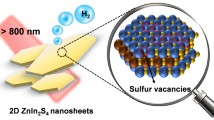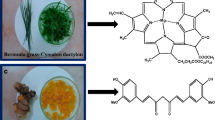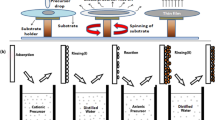Abstract
The present articles mention about induction cycle influence on physicochemical and optoelectronic properties of nanostructured In2S3 thin films synthesized on glass substrate using successive ionic layer adsorption and reaction (SILAR) techniques with the intension to test photocatalytic activity. These as-deposited thin films of different induction cycles, i.e., 80, 90, 100, and 110, are characterized for structural, compositional, optical, and electrical properties. The X-ray diffraction pattern (XRD) obtained shows polycrystalline nature of the thin films, with change in crystal geometry and structure from an amorphous to crystalline cubic. The surface morphology observed from field emission scanning electronic microscopy (FESEM) represents slight deviation from each other. The elemental composition analysis performed using energy dispersive X-ray analysis spectra (EDAX) confirmed proper stoichiometric ratio for increased immersion cycles. The extra-plotting of UV–vis data for optical band gap has shown red shift from ~ 2.66 to ~ 2.49 eV for increased immersion cycles. Trends of decrease in electrical resistivity of In2S3 thin films with an increase in immersion cycles is observed, the resistivity observed to be of the order of 104 Ω·cm. The photocatalytic activity when studied has shown that the In2S3 films with 110 immersion cycles exhibit considerable visible light photocatalytic activity.














Similar content being viewed by others
References
S. Rasool, K. Saritha, K.T. Ramakrishna Reddy, M.S. Tivanov, A.V. Trofimova, S.E. Tikoto, L. Bychto, A. Patryn, M. Maliński, V.F. Gremenok, Effect of annealing on the physical properties of thermally evaporated In2S3 thin films. Current Appl. Physics. 19, 108–113 (2019)
L. Zhang, W. Zhang, H. Yang, Fu. Wuyou, W. Zhao, H. Zhao, J. Ma, Growth studies and characterization of In2S3 films prepared by hydrothermal method and their conversion to In2O3 films. Mater. Chem. Phys. 130, 932–936 (2011)
Z. Pang, M. Zhang, Le. Huang, R. Wen, Lu. Jianting, Yu. Zhao, A. Wei, L. Tao, D. Luo, J. Liu, Y. Yang, Ye. Xiao, Z. Xiao, Synthesis of In2S3 thin films directly onto conductive substratesvia PVP-assisted microwave irradiation method. Mater. Lett. 210, 66–69 (2018)
M.G. Sandoval-Paz, M. Sotelo-Lerma, J.J. Valenzuela-Jáuregui, M. Flores-Acosta, R. Ramírez-B, Structural and optical studies on thermal-annealed In2S3 films prepared by the chemical bath deposition technique. Thin Solid Films 472, 5–10 (2005)
N. Revathi, P. Prathap, K.T. Ramakrishna Reddy, Thickness dependent physical properties of close space evaporated In2S3 films. Solid State Sci. 11, 1288–1296 (2009)
R.K. Jaspal Singh, Soni, Enhanced sunlight driven photocatalytic activity of In2S3 nanosheets functionalized MoS2 nanoflowers heterostructures. Sci. Rep. 11, 15352 (2021)
R.K. Jaspal Singh, Soni, Fabrication of nanostructured In2S3 thin film with broad optical absorption for improved sunlight mediated photocatalysis application. Opt. Mater. 122, 111748 (2021)
R.K. Jaspal Singh, Soni, Jeongyong Kim, Photocatalytic β-In2S3 nanoflowers synthesized by thermal assembly of In2S3 nanosheets. J. Alloy. Compd. 911, 165099 (2022)
Young Kim, T.S. Senthil, Byeong Sub Kwak, Misook, Kang Improved photovoltaic efficiency on TiO2/In2S3 double layered electrodes, Materials Chemistry and Physics 149, 302–308 (2005)
R. Souissi, N. Bouguila, A. Labidi, Ethanol sensing properties of sprayed β-In2S3 thin films. Sensors Actuators B. 261, 522–530 (2018)
N. Naghavi, S. Spiering, M. Powalla, B. Cavana, D. Lincot, High-efficiency copper indium gallium diselenide (CIGS) solar cells with indium sulfide buffer layers deposited by atomic layer chemical vapor deposition (ALCVD). Prog. Photovolt.: Res. Appl. 11, 437–443 (2003)
Teny Theresa John, Meril Mathew, C. Sudha Kartha, K.P. Vijayakumar, T. Abe, Y. Kashiwaba, CuInS2/In2S3 thin film solar cell using spray pyrolysis technique having 9.5% efficiency. Solar Energy Materials & Solar Cells, 89, 27–36 (2005)
W. Qiu, M. Xu, X. Yang, F. Chen, Y. Nan, J. Zhang, H. Iwaic, H. Chen, Biomolecule-assisted hydrothermal synthesis of In2S3 porous films and enhanced photocatalytic properties. Journal of Material Chem. 21, 13327–13333 (2011)
N. Revathi, P. Prathap, R.W. Miles, K.T. Ramakrishna Reddy, Annealing effect on the physical properties of evaporated In2S3 films. Solar Energy Materials Solar Cells 94, 1487–1491 (2010)
Chunyan Wu, Dun Mao, Zhu Liu, Qi Liang, Shirong Chen, Yongqiang Yu, Li Wang, Linbao Luo and Jun Xu, n-type In2S3 films deposited by pulsed laser deposition: effect of laser power on the properties of the films, Mater. Res. Express 2, 056401–056407 (2015)
A.M. Abdel Haleem, M. Ichimura, Electrochemical deposition of indium sulfide thin films using two-step pulse biasing. Thin Solid Films 516, 7783–7789 (2008)
P. M. Ratheesh Kumar, Teny Theresa John , C. Sudha Kartha, K. P. Vijayakumar, T. Abe, Y. Kashiwaba, Effects of thickness and post deposition annealing on the properties of evaporated In2S3 thin films, J. Mater Sci., 41, 5519–5525 (2006).
S. Karthikeyan, A.E. Hill, R.D. Pilkington, Low temperature pulsed direct current magnetron sputtering technique for single phase β-In2S3 buffer layers for solar cell applications. Appl. Surf. Sci. 418, 199–206 (2017)
X. Feng, Y. Chen, M. Wang, L. Guo, Hydrothermal synthesis of pyramid-like In2S3 film for efficient photo-electrochemical hydrogen generation. Int. J. Hydrogen Energy 42, 15085–15095 (2017)
K. Otto, A. Katerski, A. Mere, O. Volobujeva, M. Krunks, Spray pyrolysis deposition of indium sulphide thin films. Thin Solid Films 519, 3055–3060 (2011)
B. Yahmadi, N. Kamoun, C. Guasch, R. Bennaceur, Synthesis and characterization of nanocrystallized In2S3 thin films via CBD technique. Mater. Chem. Phys. 127, 239–247 (2011)
M. Kundakci, A. Ates, A. Astam, M. Yildirim, Structural, optical and electrical properties of CdS, Cd0.5In0.5S and In2S3 thin films grown by SILAR method. Physica E 40, 600–605 (2008)
R. Ranjith, Teny Theresa John, C. Sudha Kartha, K.P. Vijayakumar, T. Abe, Y. Kashiwaba, Post-deposition annealing effect on In2S3 thin films deposited using SILAR technique, Materials Science in Semiconductor Processing 10, 49–55 (2007).
N. Naghavi, R. Henriquez, V. Laptev, D. Lincot, Growth studies and characterization of In2S3 thin films deposited by atomic layer deposition (ALD). Appl. Surf. Sci. 222, 65–73 (2004)
X. Fu, X. Wang, Z. Chen, Z. Zhang, Z. Li, Y.C. Dennis Leung, L. Wu, X. Fu, Photocatalytic performance of tetragonal and cubic β-In2S3 for the water splitting under visible light irradiation. Appl. Catal. B.: Environ. 95, 393–399 (2010)
J. Feng, Z. Yang, S. He, X. Niu, T. Zhang, A. Ding, H. Liang, X. Feng, Photocatalytic reduction of Uranium (VI) under visible light with Sn-doped In2S3 microspheres. Chemosphere 212, 114–123 (2018)
Y.B. Salem, M. Kilani, N. Kamoun, Effect of deposition runs on the physical properties of In2S3 chemically synthesized for photocatalytic application. Results Physics 10, 706–713 (2018)
N. Asim, S. Ahmadi, M.A. Alghoul, F.Y. Hammadi, K. Saeedfar, K. Sopian, Research and development aspects on chemical preparation techniques of photoanodes for dye sensitized solar cells. Intl. J. Photoenergy 2014, 22 (2014)
S.S. Karade, P. Dwivedi, S. Majumder, B. Pandit, B.R. Sankapal, First report on FeS-based 2V operating flexible solid-state symmetric supercapacitor device, Sustainable. Energy Fuels 1, 1366–1375 (2017)
D.A. Shende, Y.N. Rane, M.G. Raghuwanshi, N.M. Gosavi, S.R. Gosavi, N.G. Deshpande, Visible-light-driven photocatalytic activity of mixed phase CdS-flakes. Optik 161, 284–292 (2018)
K. Gowrish Rao, V.K. Ashith, Influence of deposition parameters on the structural and optical properties of CdS thin films obtained by micro-controlled SILAR deposition. J. Physics Chem. Solids 77, 14–22 (2015)
D.S. Dhawale, D.P. Dubal, M.R. Phadatare, J.S. Patil, C.D. Lokhande, Synthesis and characterizations of CdS nanorods by SILAR method: effect of film thickness. J. Mater. Sci. 46, 5009–5015 (2011)
JCPDS data card no. 73–1366.
Abebe G. Habte, Fekadu Gashaw Hone, F.B. Dejene, The influence of malonic acid on the structural, morphological and optical properties of CdSe thin films prepared by chemical bath deposition method.Inorg. Chem. Commun. 103, 107–112 (2019)
K.C. Preetha, T.L.Remadevi, Effect of Al incorporation on the structural, morphological, optoelectronic and transport properties of PbS thin films. Physica. B. Condensed. Matter.407, 4173–4181 (2012)
S. Ravi Shankar, A.R. Balu, M. Anbarasi, V.S. Nagarethinam, Influence of precursor molar concentration on the structural, morphological, optical and electrical properties of PbS thin films deposited by spray pyrolysis technique using perfume atomizer. Optik 126, 2550–2555 (2015)
E. Veena, Kasturi V. Bangera, G.K. Shivakumar, Effective role of thickness on structural, electrical and optical properties of lead sulphide thin films for photovoltaic applications. Mater. Sci. Eng. B. 223, 64–69 (2017)
B. Tiss, M. Erouel, N. Bouguila, M. Kraini, K. Khirouni, Effect of silver doping on structural and optical properties of In2S3 thin films fabricated by chemical pyrolysis. J. Alloy. Compd. 771, 60–66 (2019)
T. Theresa John, C. SudhaKartha, K.P. Vijayakumar, T. Abe, Y. Kashiwaba, Preparation of indium sulfide thin films by spray pyrolysis using a new precursor indium nitrate. Appl. Surface. Sci. 252, 1360–1367 (2005)
S. Chander, A. Purohit, C. Lal, M.S. Dhaka, Enhancement of optical and structural properties of vacuum evaporated CdTe thin films. Mater. Chem. Physics. 185, 202–209 (2017)
S. Mahato, A.K. Kar, Structural, optical and electrical properties of electrodeposited cadmium selenide thin films for applications in photodetector and photo-electrochemical cell, Journal of Electro-analytical. Chem. 742, 23–29 (2015)
R.B. Kale, C.D. Lokhande, Band gap shift, structural characterization and phase transformation of CdSe thin films from nanocrystalline cubic to nanorod hexagonal on air annealing. Semicond. Sci. Technol. 20, 1–9 (2005)
K.B. Chaudhari, N.M. Gosavi, N.G. Deshpande, S.R. Gosavi, Chemical synthesis and characterization of CdSe thin films deposited by SILAR technique for optoelectronic applications. J. Sci.: Adv. Mater. Devices 1, 476–481 (2016)
Y.N. Rane, D.A. Shende, M.G. Raghuwanshi, R.R. Koli, S.R. Gosavi, N.G. Deshpande, Visible-light assisted CdO nanowires photocatalyst for toxic dye degradation studies. Optik - Intl. J. Light Electron Optics 179, 535–544 (2019)
Acknowledgements
The authors would like to extend their sincere appreciation to the University Institute of Chemical Technology (UICT), Kavayitri Bahinabai Chaudhari North Maharashtra University, Jalgaon for providing the characterization facilities. The author also gratefully acknowledges Management Members and Principal of C.H.C. Arts, S.G.P. Commerce, and B.B.J.P. Science College, Taloda for constant encouragement and kind support in the research activity.
Author information
Authors and Affiliations
Corresponding authors
Ethics declarations
Conflict of interest
The authors declare no competing interests.
Rights and permissions
Springer Nature or its licensor (e.g. a society or other partner) holds exclusive rights to this article under a publishing agreement with the author(s) or other rightsholder(s); author self-archiving of the accepted manuscript version of this article is solely governed by the terms of such publishing agreement and applicable law.
About this article
Cite this article
Kakade, B.N., Gosavi, N.M., Sali, K.R. et al. Induction cycle influence on physicochemical and optoelectronic properties of nanostructured In2S3 thin films for photocatalytic activity. emergent mater. 5, 1959–1971 (2022). https://doi.org/10.1007/s42247-022-00429-0
Received:
Accepted:
Published:
Issue Date:
DOI: https://doi.org/10.1007/s42247-022-00429-0




